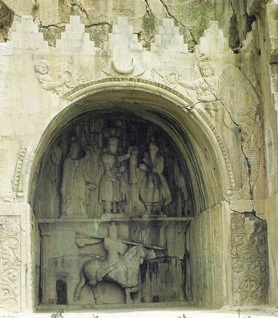Taqhe Bostan (Persian: طاق بستان) is a major heritage site in Western Iran (located approx. 5-6 km from the city of Kermanshah) dated to the Sassanian era (224-651 CE). The site is extremely valuable for the understanding of the Sassanian era, especially its rock-reliefs and fine carvings typical of the later Sassanian era. Taghe Bostan is one of thirty known Sassanian sites along the Zagros mountain chain.
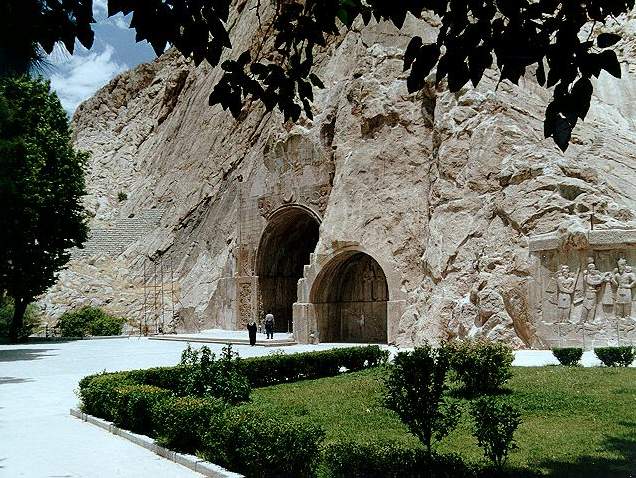 An excellent panoramic view of Taghe Bostan (Photo Source: Graduate School of Razi University in Kermanshah).
An excellent panoramic view of Taghe Bostan (Photo Source: Graduate School of Razi University in Kermanshah).
Taqhe Bostan’s artistic themes are essentially exhibit the following themes popular in Sassanian arts: martial ardor, strength, mythological themes, Farr (Divine Glory), the sense of honor, the Royal hunt, the Royal Feast, celebrations and joy, and the glories of the court.
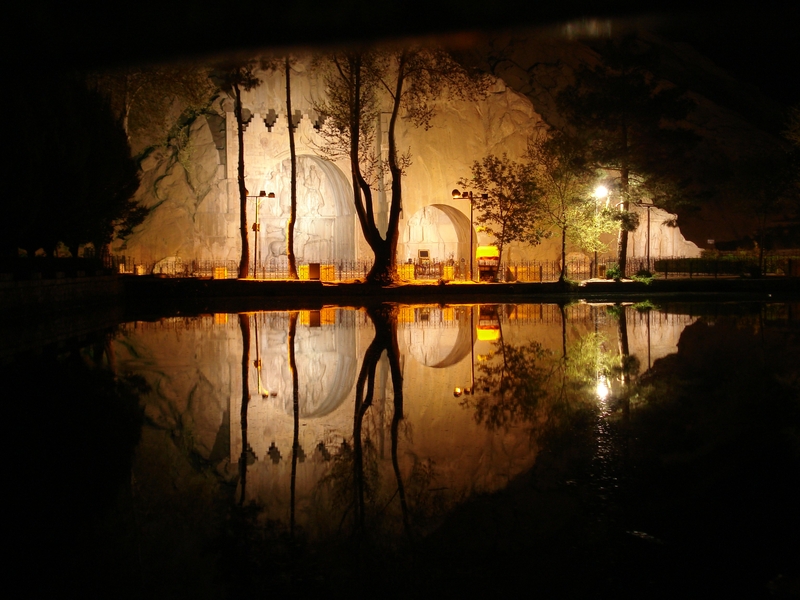 Another excellent panoramic view of Taghe Bostan from the waterway ingress at night (Photo Source: Graduate School of Razi University in Kermanshah).
Another excellent panoramic view of Taghe Bostan from the waterway ingress at night (Photo Source: Graduate School of Razi University in Kermanshah).
Panel with Ardashir II
The four-figure rock-relief panel featuring Ardashir II r. 379-383 CE) is probably the oldest at Taghe Bostan.
Ardashir II (standing in the middle) receives a large “Farr” ring (with ribbons – a commons Sassanian symbol of royalty) which is a symbol of regal investiture from a figure which believed to be either Ahura-Mazda or possibly Shapur II (r.309-379 AD) (figure to the right). Note that Shapur II was Ardashir II’s predecessor.
Ardashir II acted as the interim ruler for the actual heir of the throne Shapur III (383-388 CE), as the latter was still too young to rule.
The third figure (at left) is the god Mithra who holds a symbolic broadsword-like Barsum in his hands. Mithras is not only the guardian of contracts, he is also the god who provides the warrior with courage, endurance, resilience and martial ardor. It is also interesting that Mithra stands on a lotus flower. Finally, one sees the prostrate figure of Roman emperor Julian the Apostate(r.361-363 CE). The figure of Julian symbolizes his defeat after his massive of invasion of Persia was defeated in 363 CE (Julian was also killed during the failed campaign). Panel with Shapur II and Shapur III Taghe Bostan has a smaller Iwan archway as well featuring the figures of Shapur II and III carved into the relief. This Iwan is interesting as it features two distinct inscriptions in Pahlavi of Shapur II and his son Shapur III. The translation of the Pahlavi inscription at Iwan pertaining to Shapur II is as follows: “This is the [form of] Mazda-worshiping Lord Shapur, Shahanshah [king of kings] of Eran [Iran] and An-Eran [non-Iran], whose race is from the Gods. Son of Mazda-worshiping Lord Hormizd, Shahanshah of Eran and An-Eran, whose race is from the Gods, grandson of Lord Narse, the Shahanshah.“ The translation of the Pahlavi inscription at the Iwan pertaining to Shapur III is as follows: “This is the [form of] Mazda-worshiping Lord Shapur, Shahanshah [king of kings] of Eran [Iran] and An-Eran [non-Iran], whose race is from the Gods. Son of Mazda-worshiping Lord Shapur, Shahanshah of Eran and An-Eran, whose race is from the Gods, grandson of Lord Hormizd, the the Shahanshah.“ It must be noted that the date of this Iwan and its inscriptions are debated. There are also questions as to whether the inscriptions were added ‘after the fact” by Shapur III. The Grand Iwan The overall frontal archway of the Grand Iwan or archway of the Taghe Bostan is distinct and imposing. A discussion of this segment of Taghe Bostan is in essence a four-part discussion that focuses on: (1) Overall Frontal View The grand Iwan or archway at Taghe Bostan is an impressive structure carved out of the solid rock. Distinctly visible are the arboreal patterns conveying the branches and segments of the sacred tree of life, a mythological pattern common to Iranian peoples since antiquity and especially among the Scythians and the Sarmatians-Alans. Especially impressive at the grand entrance way are the female angelic or Yazata figures, one at each side of the archway. Much of the artwork for the angel at the left side has collapsed (or suffered damaged) but her head and outstretched right hand holding the “Farr” [Divine Glory] are still intact. The angel on the right side is considerably more intact : her wings and attire are clearly visible and like her left counterpart, she too holds the “Farr” [Divine Glory] with an outstretched right hand. The right hand angel also holds what appears to be a cup filled with roundels (grapes?) with her left hand. (2) Investiture of Khosrow II The investiture of Khosrow II (r. 590-628 CE) is depicted in the upper panel of the interior of the Grand Iwan at Taghe Bostan. There are three figures in this scene with Khosrow II seen in the middle clasping a ceremonial and highly decorated broadsword with his left hand. Khosrow II is seen receiving a regal Farr diadem with ribbons from Ahura-Mazda (other researchers however, suggest that this is a Zoroastrian priest). To the left of Khosrow II stands Goddess Anahita who is holding a regal Farr diadem as well; again some researchers have suggested that this figure is not Goddess Anahita and simply depicts a priestess instead. (3) Khosrow II as Armored Knight The lower section of the Grand Iwan features a highly detailed statue of a late Sassanian armored knight. The figure, generally identified as Khosrow II (r. 590-628 CE) and his steed Sabdiz, provides valuable information on late Sassanian helmet featuring “eyebrow” view slits, Bargostvan (horse armor), mail, attire and the lappet suspension system. As the feet of the statue are broken off, it is not clear if the knight was using stirrups. The Sassanians most likely deployed stirrups given the important but little known discovery of a pair of iron stirrups dated to the late Sassanian era or the 6th – 7th centuries CE in Iran’s Marlik region. (4) Panels featuring the Royal Hunt At the ingress into the Grand Iwan stand two panels depicting the Royal Hunt. The panel at left side of the grand Iwan depicts the hunting of boars. The panel also shows elephants and mahouts. Notable in the left panel is the portrayal of Khosrow II in a boat shooting a boar – there are two distinct “frames” of this: first the boars is shown leaping towards the king and in the next “panel” the boar is killed. Khosrow is seen accompanied by musicians in a second boat. The right panel at the ingress into the Taghe Bostan archway depicts another Royal Hunt. This scene is that of a great deer hunt which takes place within an enclosure or “Pardis”. In one depiction at the right panel shown above, Khosrow II is provided shade with an umbrella handled by a courtier while he rests his hand on the sword handle. Another depiction is that of rider (possibly again Khosrow II or one of the Savaran knights) about to shoot an arrow downwards towards prey; the sword is suspended at an angle consistent with the lappet-suspension method of Central Asia. Herrmann has argued that the level platform of the rider’s feet suggest that he was probably using stirrups. Musicians are again present in the right panel as well, on the upper left hand side of the picture. Epilogue: Old Photos of Taghe Bostan Below are old photos of Taghe Bostan.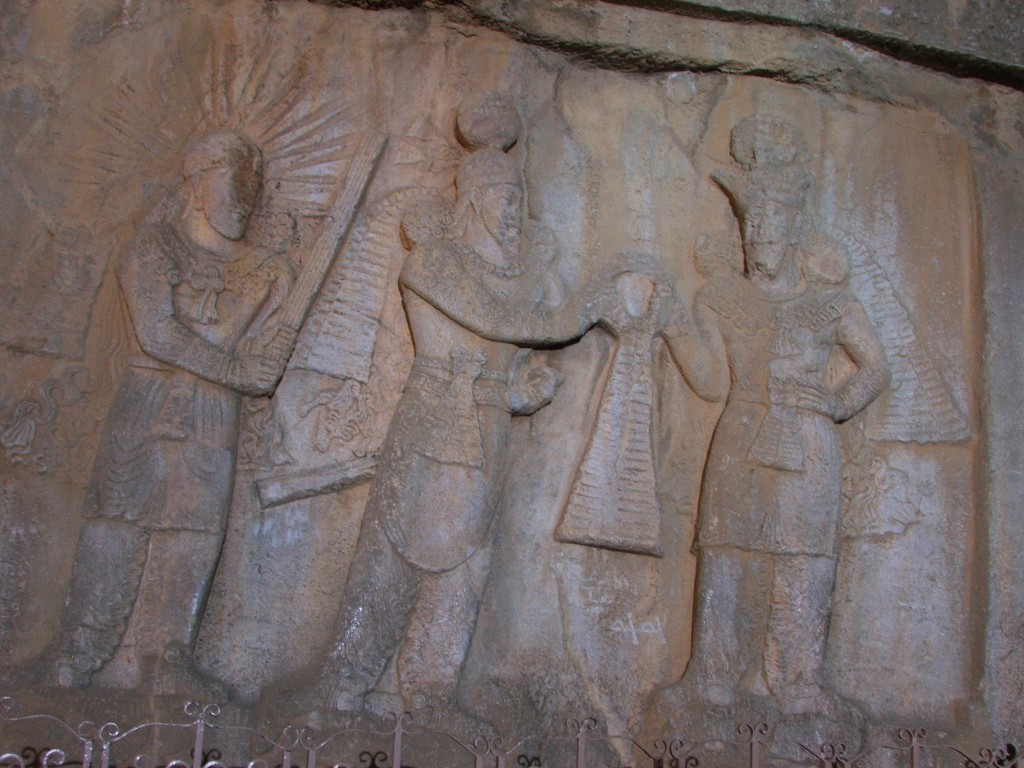
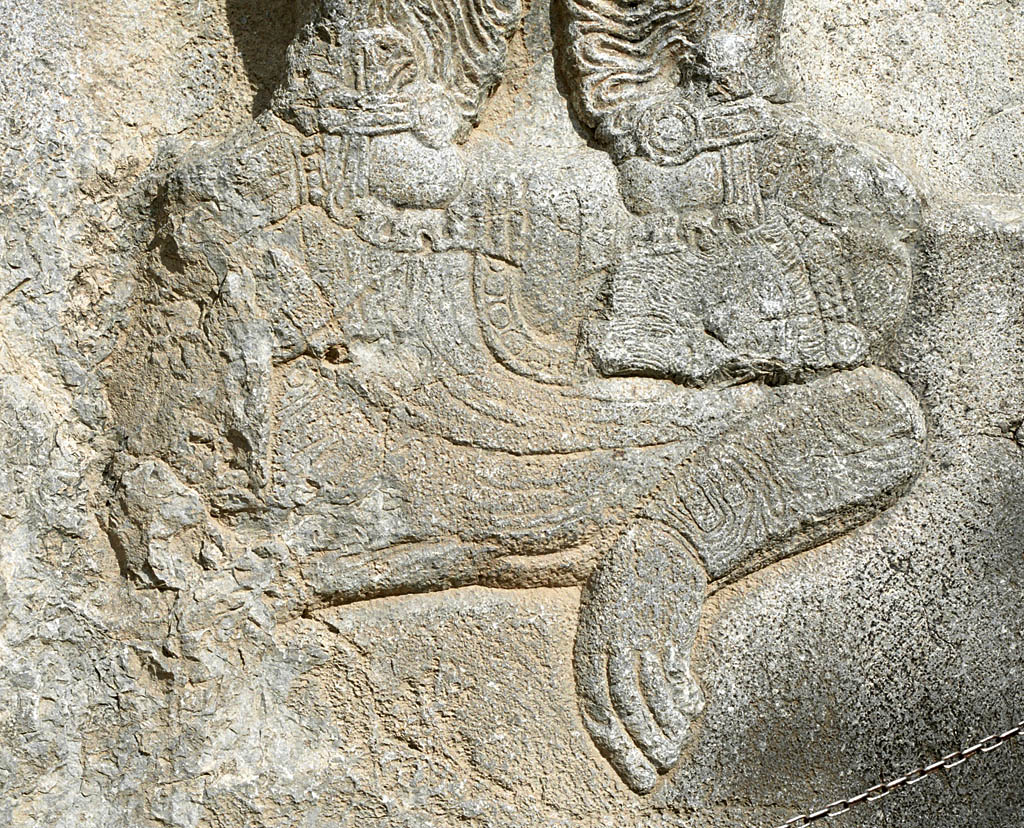 [Click to Enlarge] The fallen figure of Julian the Apostate at the Ardashir II relief (Photo Source: Public Domain).
[Click to Enlarge] The fallen figure of Julian the Apostate at the Ardashir II relief (Photo Source: Public Domain).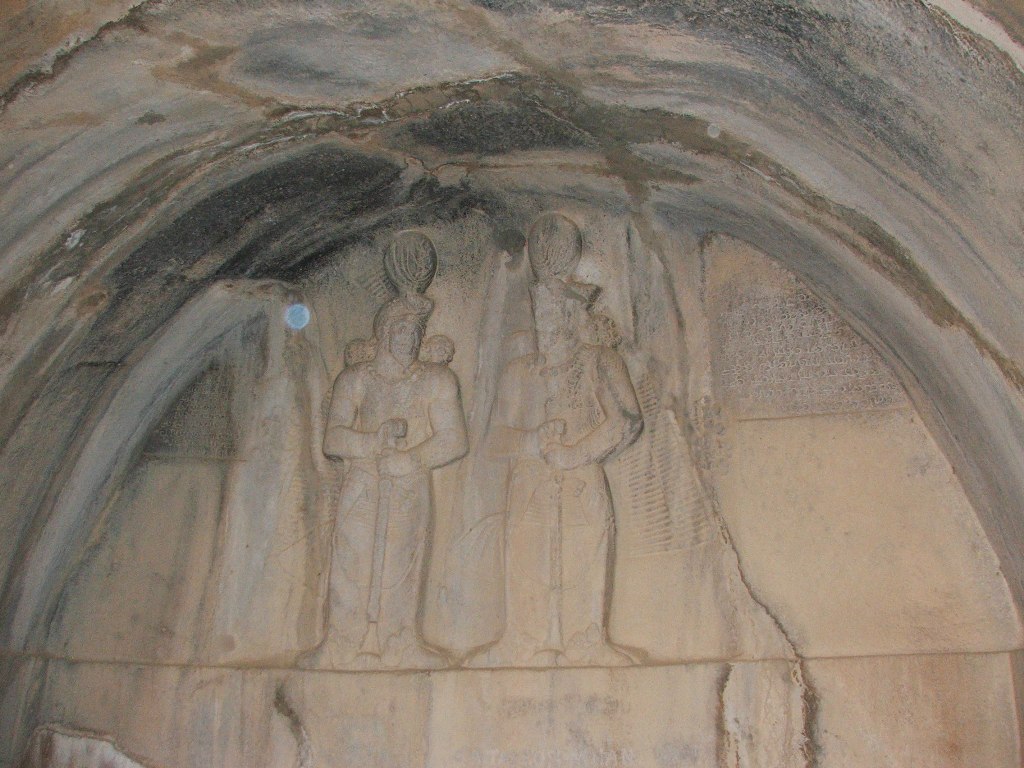 [Click to Enlarge] The figures of King Shapur II (right) facing his son Shapur III (left) standing at around 3 meters tall each. Note ceremonial stance of the warriors with palm of hand placed on top of sword hilt and left hand grasping hilt-handle (Photo Source: Shahyar Mahabadi, 2004).
[Click to Enlarge] The figures of King Shapur II (right) facing his son Shapur III (left) standing at around 3 meters tall each. Note ceremonial stance of the warriors with palm of hand placed on top of sword hilt and left hand grasping hilt-handle (Photo Source: Shahyar Mahabadi, 2004). 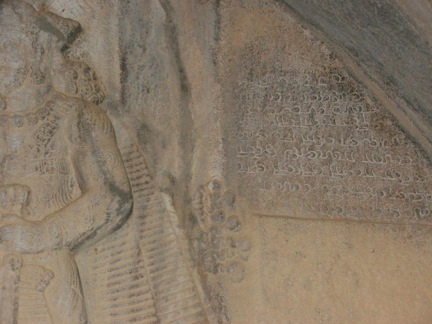 A close-up view of a Pahlavi inscription at the Shapur II-Shapur III panel at Taghe Bostan (Photo Source: Shahyar Mahabadi, 2004). Note that the figure to the right of the photo is the partial view of Shapur III.
A close-up view of a Pahlavi inscription at the Shapur II-Shapur III panel at Taghe Bostan (Photo Source: Shahyar Mahabadi, 2004). Note that the figure to the right of the photo is the partial view of Shapur III.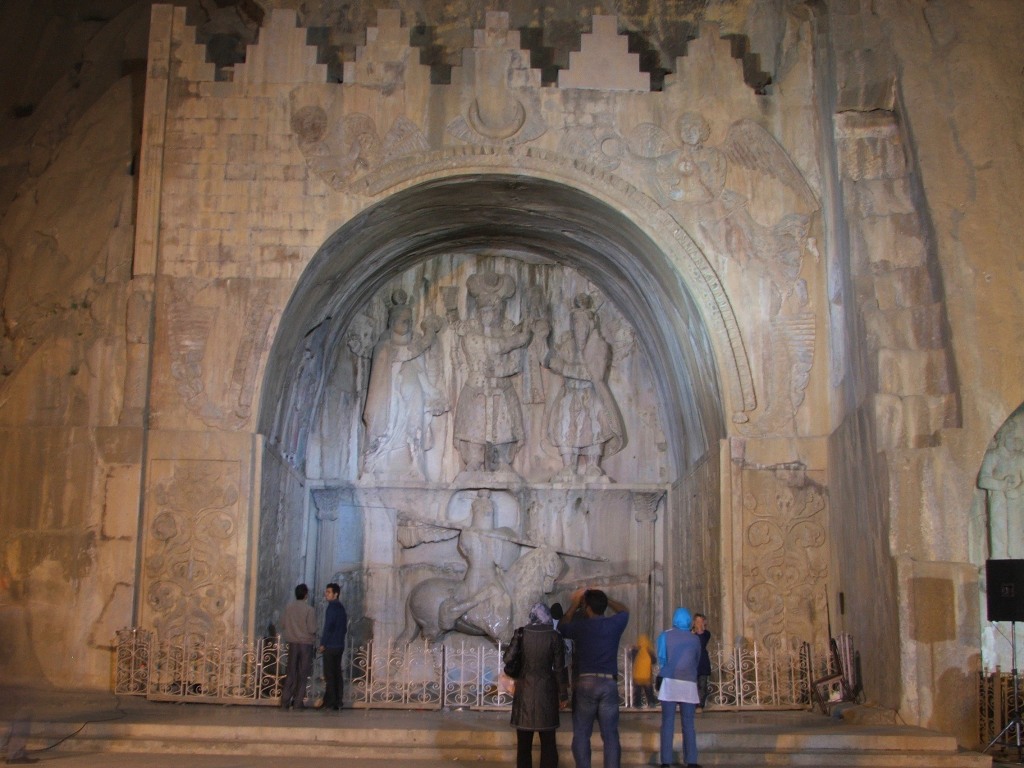 The great grotto of Khosrow II at Tagh-e-Bostan. Visible are the arch of the Iwan, the upper register on the back wall featuring the investiture of Khosrow II with the lower section clearly showing the armored knight figure of Khosrow II and his steed Sabdiz (Photo: Shahyar Mahabdi, 2004).
The great grotto of Khosrow II at Tagh-e-Bostan. Visible are the arch of the Iwan, the upper register on the back wall featuring the investiture of Khosrow II with the lower section clearly showing the armored knight figure of Khosrow II and his steed Sabdiz (Photo: Shahyar Mahabdi, 2004).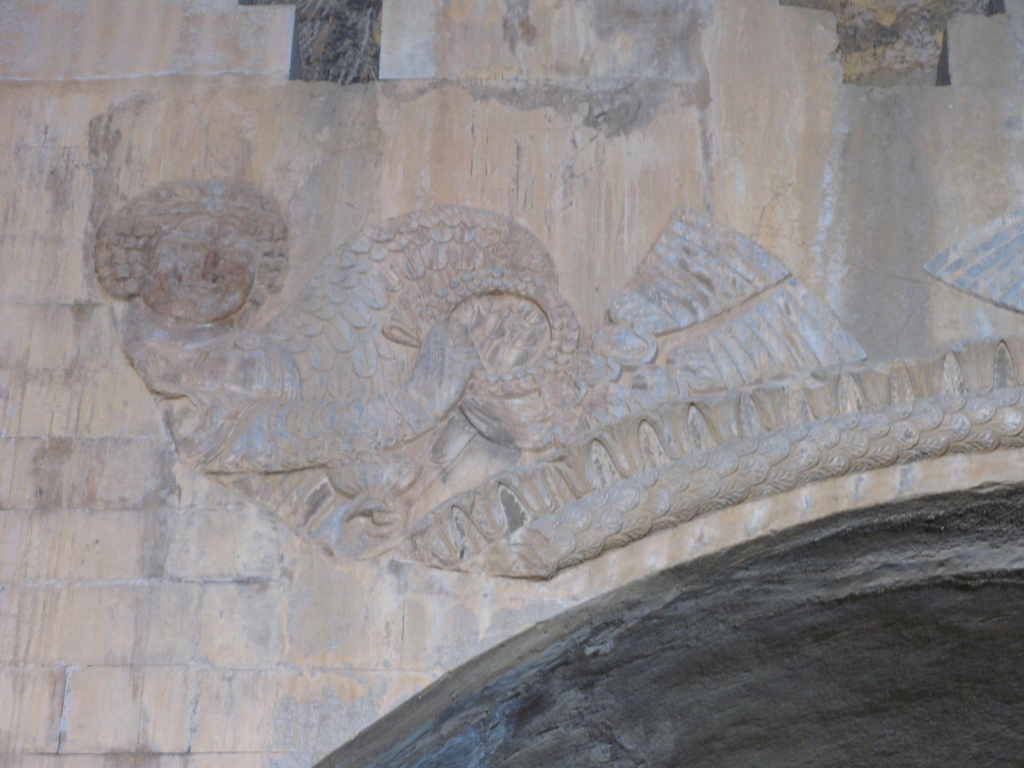 [Click to Enlarge] The Yazata or Angel at the upper left side of the archway of the Grand Iwan at Taghe Bostan (Photo courtesy of S. Amiri-Parian). Note the fluttering ribbons, a consistent Sassanian theme of regal splendor.
[Click to Enlarge] The Yazata or Angel at the upper left side of the archway of the Grand Iwan at Taghe Bostan (Photo courtesy of S. Amiri-Parian). Note the fluttering ribbons, a consistent Sassanian theme of regal splendor.
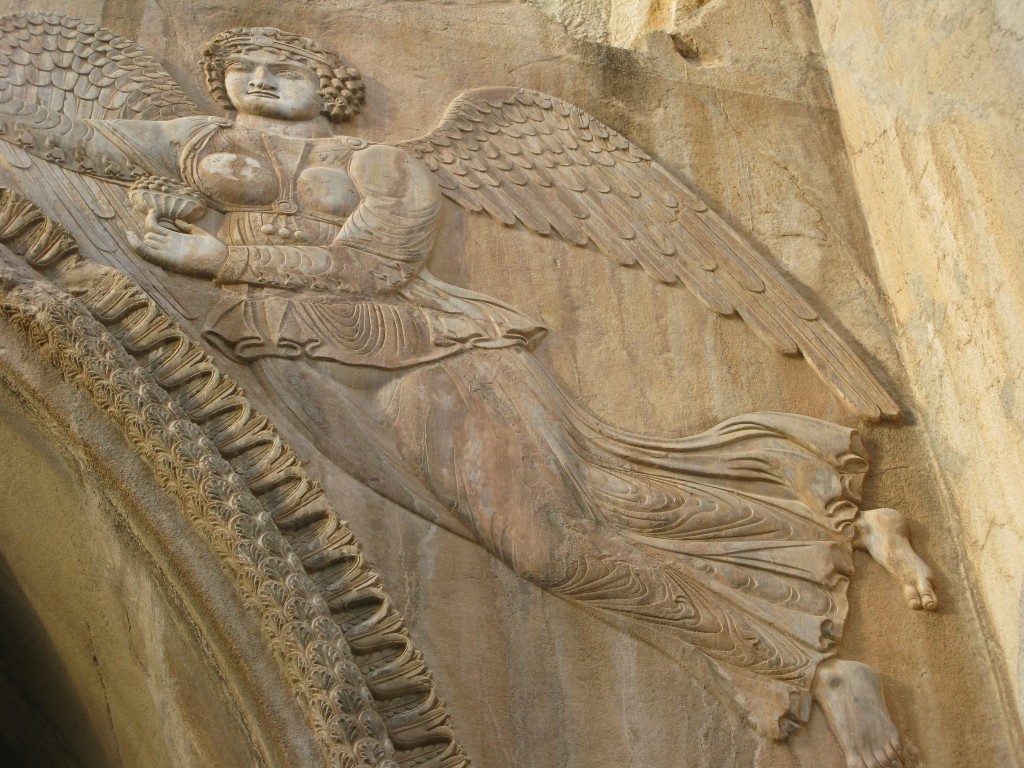 [Click to Enlarge] The Yazata or Angel at the upper right side of the archway of the Grand Iwan at Taghe Bostan (Photo courtesy of S. Amiri-Parian).
[Click to Enlarge] The Yazata or Angel at the upper right side of the archway of the Grand Iwan at Taghe Bostan (Photo courtesy of S. Amiri-Parian).
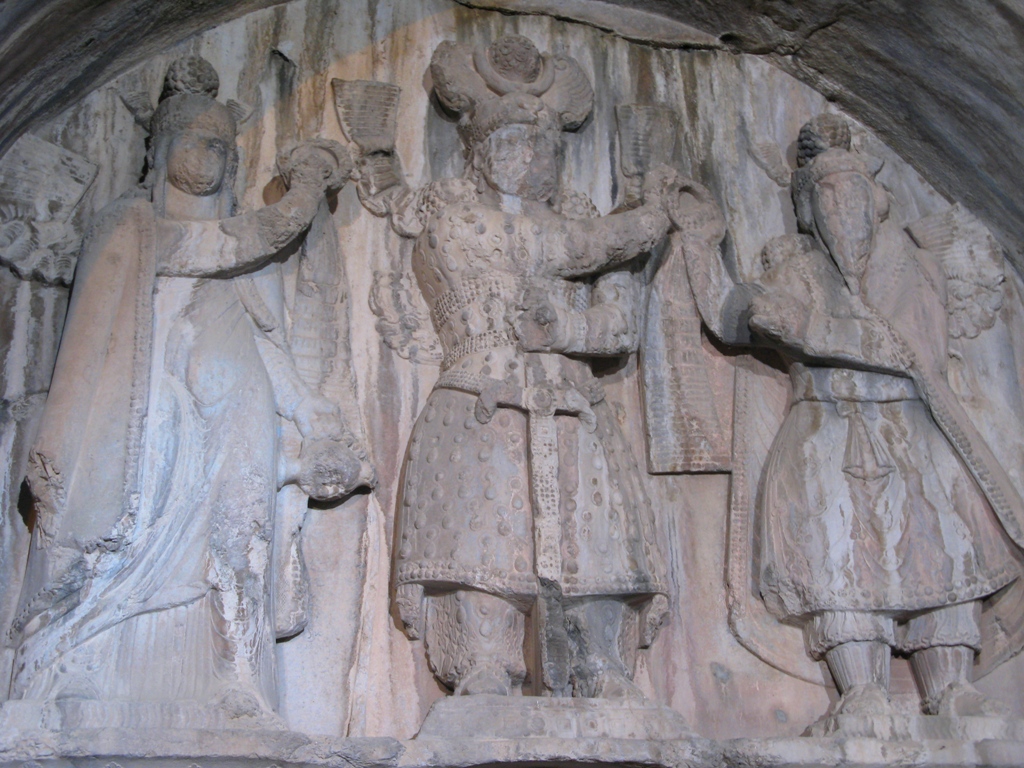 [Click to Enlarge] Investiture scene above the late Sassanian armored knight at the vault at Tagh-e Bostan. To the left stands Goddess Anahita with her right hand raised, holding a diadem of glory or “Farr” towards Khosrow II at center who receives a diadem with his right hand from Ahura-Mazda or the chief Magus. Anahita was a revered goddess of war among Sassanian warriors (Source: Shahyar Mahabadi, 2004).
[Click to Enlarge] Investiture scene above the late Sassanian armored knight at the vault at Tagh-e Bostan. To the left stands Goddess Anahita with her right hand raised, holding a diadem of glory or “Farr” towards Khosrow II at center who receives a diadem with his right hand from Ahura-Mazda or the chief Magus. Anahita was a revered goddess of war among Sassanian warriors (Source: Shahyar Mahabadi, 2004).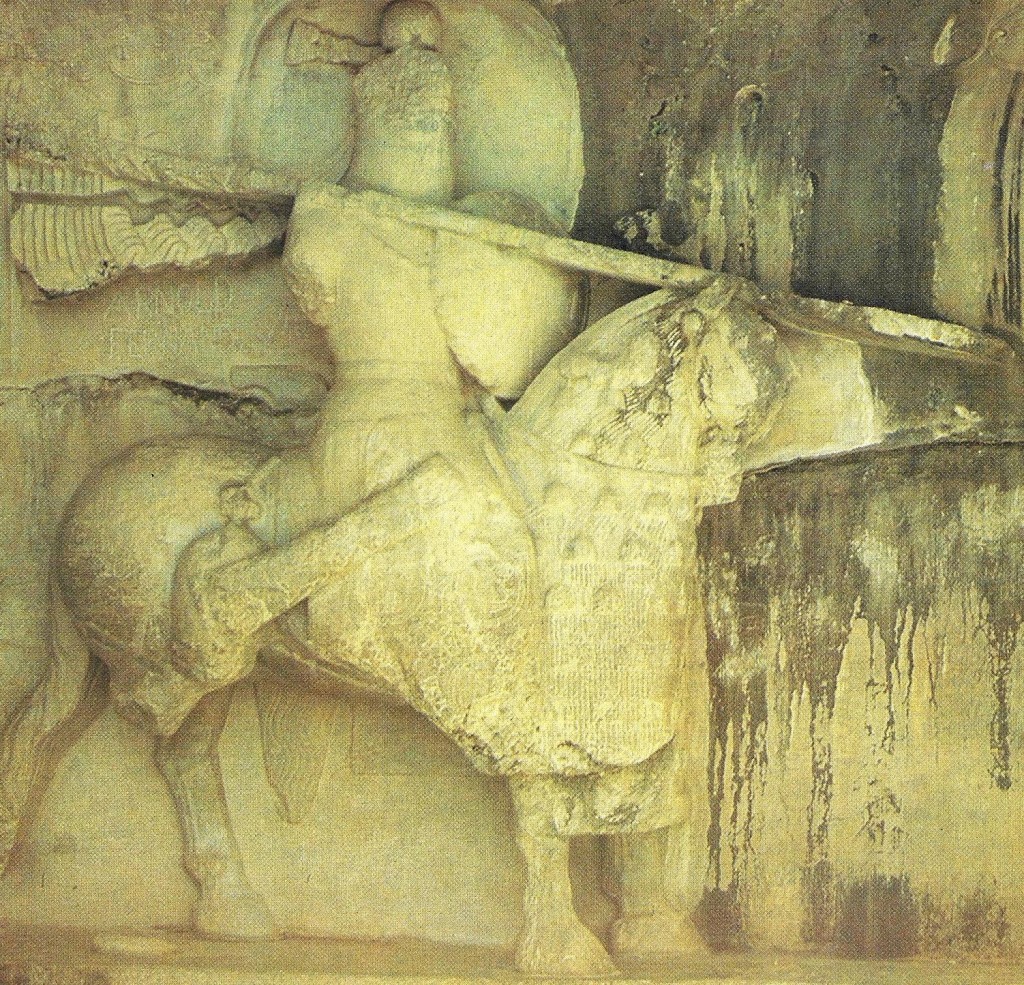 The Late Sassanian knight believed to be Khosrow II and his steed Sabdiz at the great vault or Iwan at Taghe Bostan (Photo: Kamran Sheybanipour).
The Late Sassanian knight believed to be Khosrow II and his steed Sabdiz at the great vault or Iwan at Taghe Bostan (Photo: Kamran Sheybanipour). 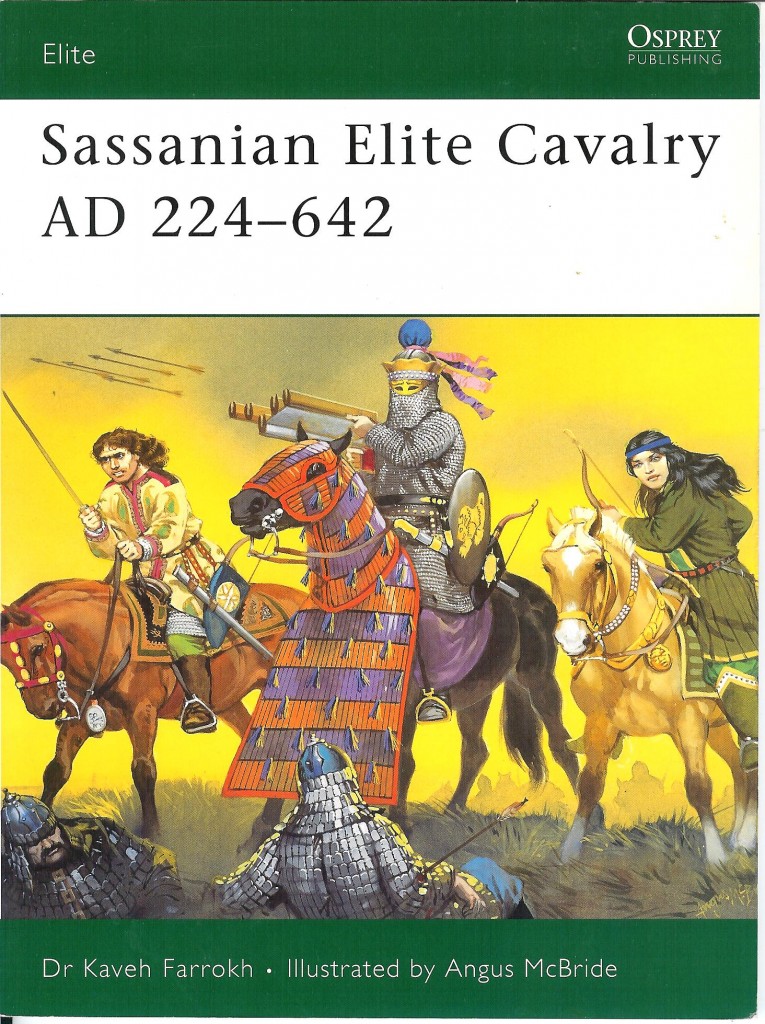 Recreation of the Taghe Bostan among the Sassanian Elite cavalry (top photo – middle figure with hypothetical Panjgan arrow firing device (Historical artist the late Angus Mcbride; Farrokh, K. Elite Sassanian Cavalry-اسواران ساسانی-, 2005, Osprey Publishing).
Recreation of the Taghe Bostan among the Sassanian Elite cavalry (top photo – middle figure with hypothetical Panjgan arrow firing device (Historical artist the late Angus Mcbride; Farrokh, K. Elite Sassanian Cavalry-اسواران ساسانی-, 2005, Osprey Publishing).
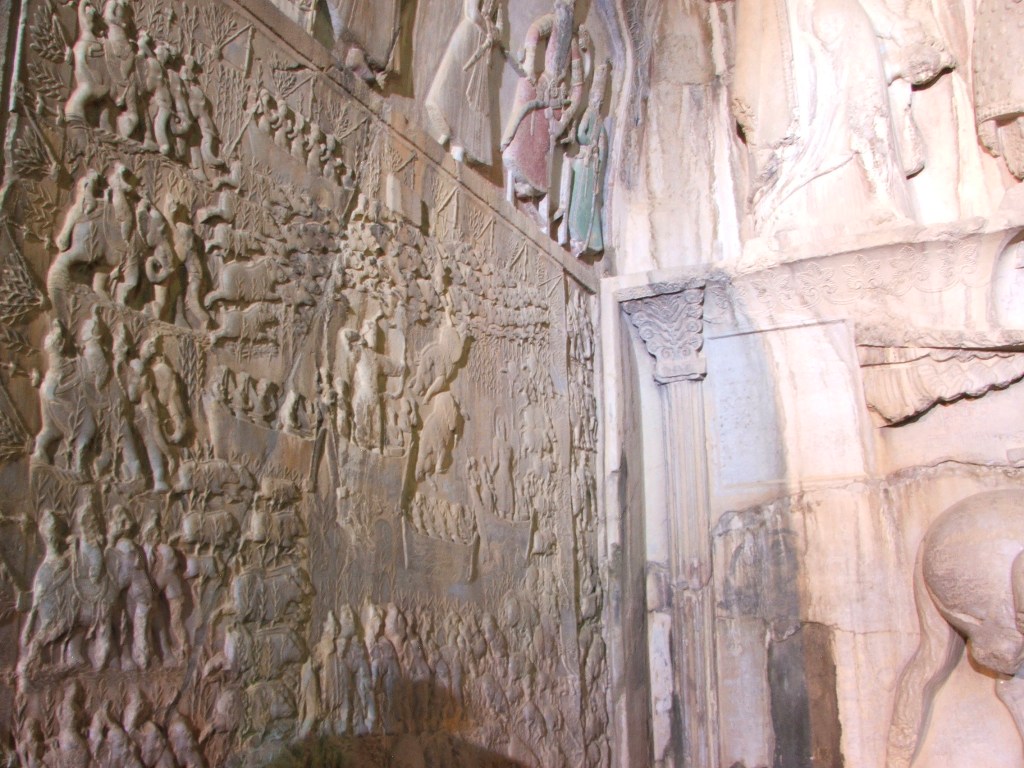 [Click to Enlarge] The left panel of the Royal Hunt scene at Taghe Bostan (Photo: Shahyar Mahabadi, 2004). Note that just above the left boar hunt panel can be seen the post-Islamic era relief of the Fathali Shah (1772-1834) of the Qajar Dynasty (1785-1925), which suggests that the Iranians were cognizant of the military exploits of ancient pre-Islamic Persia before the advent of Western academic studies into this domain.
[Click to Enlarge] The left panel of the Royal Hunt scene at Taghe Bostan (Photo: Shahyar Mahabadi, 2004). Note that just above the left boar hunt panel can be seen the post-Islamic era relief of the Fathali Shah (1772-1834) of the Qajar Dynasty (1785-1925), which suggests that the Iranians were cognizant of the military exploits of ancient pre-Islamic Persia before the advent of Western academic studies into this domain.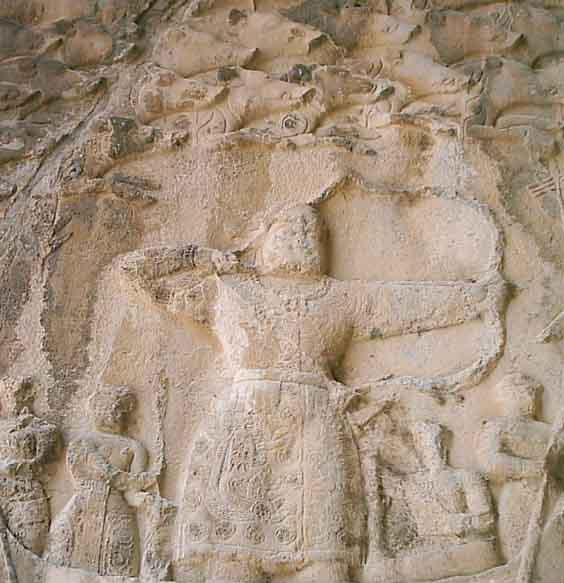 [Click to Enlarge] Close-up of the king engaged in archery in the left (boar hunt) panel (Photo: Javad Chamanara, 2004).
[Click to Enlarge] Close-up of the king engaged in archery in the left (boar hunt) panel (Photo: Javad Chamanara, 2004).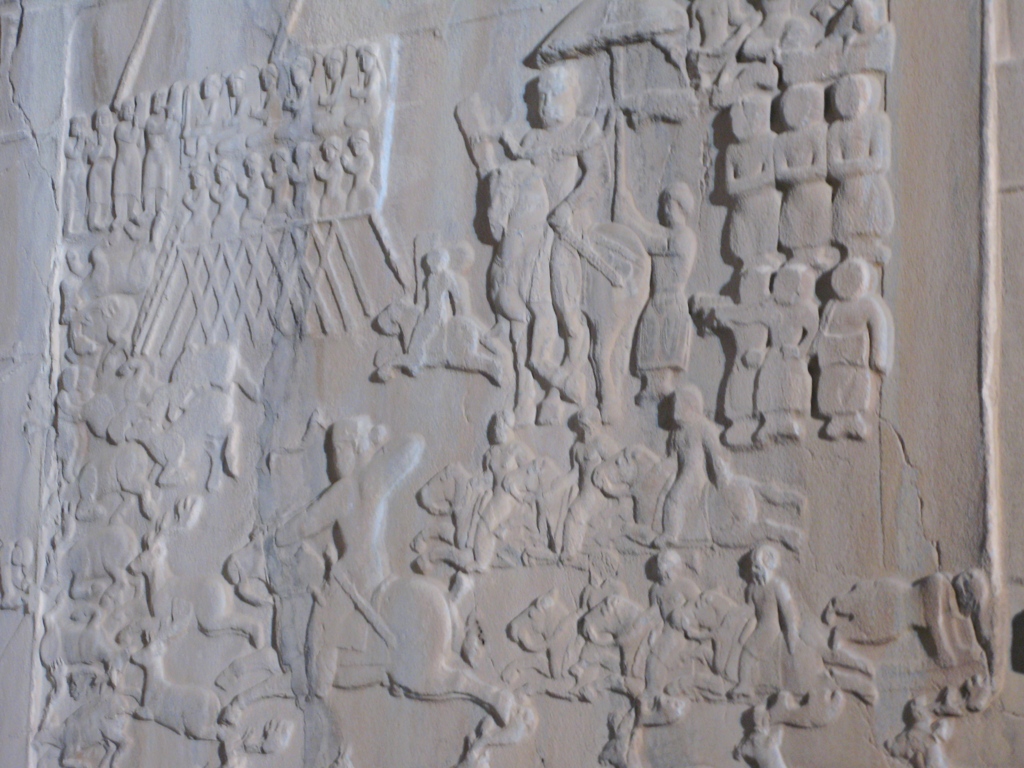 [Click to Enlarge] The right panel of the Royal Hunt scene at Taghe Bostan (Photo: Shahyar Mahabadi, 2004).
[Click to Enlarge] The right panel of the Royal Hunt scene at Taghe Bostan (Photo: Shahyar Mahabadi, 2004).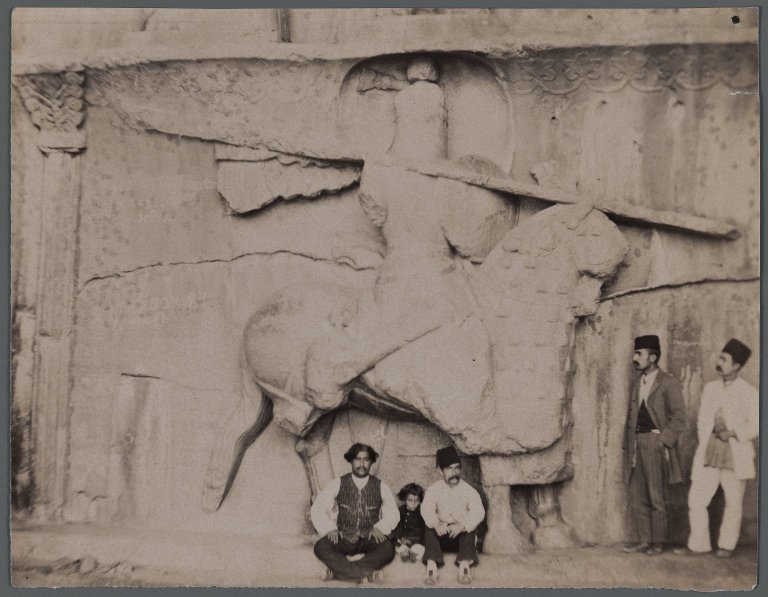 Old photo of the late Sassanian knight at Taghe Bostan during the Qajar era (likely late 19th century) (Forwarded to Kavehfarrokh.com by Shahyar Mahabadi).
Old photo of the late Sassanian knight at Taghe Bostan during the Qajar era (likely late 19th century) (Forwarded to Kavehfarrokh.com by Shahyar Mahabadi). 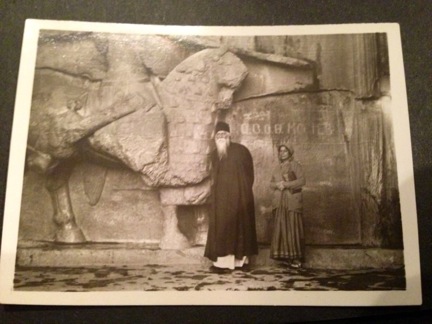 Old photo of the late Sassanian knight at Taghe Bostan dated to 1932 (courtesy of: Cyrus Ashayeri).
Old photo of the late Sassanian knight at Taghe Bostan dated to 1932 (courtesy of: Cyrus Ashayeri).

